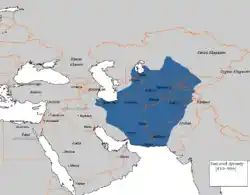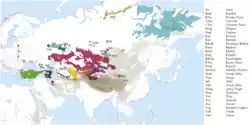
Central Asian ethnicity indicates genetic origins in Central Asia, an area as diverse culturally as it is ecologically. Hosting a wide variety of ecological zones, including arid deserts, precipitous snow-capped mountain ranges, and the wide grassland plains of the Eurasian steppes, this region encompasses modern-day Afghanistan, Kazakhstan, Kyrgyzstan, Tajikistan, Turkmenistan, and Uzbekistan: the so-called “stans,” known so for their collective suffix, which means “land of” in Persian. Central Asian people trace their origins to Iranian and later Turkic nomadic tribes who inhabited the land which stretches along the Silk Road between the Caspian Sea to the west and China to the east. The countries of this region are not ethnically homogeneous, and include minorities of other Central Asian peoples. Other communities of Central Asians and people of Central Asian descent can be found all across the world, including Eastern and Western Europe, the Middle East, the Americas, and more.
Research your ancestors on MyHeritage
Central Asian historyCentral Asian history

In the first millennium B.C.E., the steppes of Central Asia were inhabited by Iranian nomadic groups, such as the Cimmerians and the Scythians. To the east, the Xiongnu, a tribal confederation of nomadic peoples, became the dominant force of the Mongolian steppes in the 2nd century B.C.E. The Xiongnu empire dissolved at the turn of the Common Era and was replaced by the powerful but short-lived Juan-juan Empire. It has been speculated that the Xiongnu are related to the Huns, an Iranian nomadic people who in the 4th century migrated westward from Central Asia into Eastern Europe. Under the leadership of their king, Attila, the Huns made frequent ravaging raids into the Eastern Roman Empire. In the 6th century, the Turks — a tribe living within the Juan-juan Empire — revolted and seized power, establishing an empire that would become the dominant force in Asia for two centuries. The Turks played a considerable role in history, linking China, Iran, India, and Byzantium, and giving their name to peoples within that region who adopted the Turkic languages.
In the 8th century, the Turks were ousted by the Turkic-speaking Uighurs, who in turn were invaded and overturned a century later by another Turkic people, the Kyrgyz. The Persian Saminid dynasty (819–999) conquered and cultivated Transoxiana, the area between the Amu Darya and Syr Darya rivers in modern-day Uzbekistan which house the great Muslim cities of Bukhara and Samarkand. Under the influence of Persian sultanates and emirates, most of the Turkic khanates of Central Asia converted to Islam in the 10th century, a process which had a profound impact on indigenous cultures in the region.
In the early 13th century, following successful campaigns against the Chinese, Genghis Khan led a series of western campaigns, overrunning Central Asia on his way to establish the Mongol Empire: the largest contiguous land empire in history. Genghis’ second son, Chagatai Khan, established the Chagatai Khanate in the area stretching from the Amu Darya in the west to the Altai Mountains in the east. During the mid-14th century, the Chagatais lost Transoxiana to the Turco-Mongol Timurid dynasty, led by the legendary warrior-prince Timur (also known as Tamerlane). Throughout the second half of the 15th century, western Central Asia was divided into a number of rival principalities ruled by descendants of Timur. Unceasing conflicts weakened these principalities, which ultimately succumbed to the Uzbeks, another people of Turco-Mongol descent. Since that point, the Uzbek khanate of Transoxiana remained the major power of Central Asia until the 19th century, when it came under Russian rule.

The Russian Empire had been pushing southward into Central Asia since the 18th century, but it was only in the first half of the 19th century that Russia managed to gain a substantial foothold in the area. By the end of the century, the Russians had established Russian Turkestan, encompassing all of modern Central Asia, barring Afghanistan, over which the Russian and British Empires were in perpetual confrontation (known as the “Great Game”) throughout the 19th century. Following the October Revolution in 1917, Central Asia came under Soviet control. A final failed Russian attempt to annex Afghanistan came between 1979 and 1989, during the Soviet-Afghan War. In 1991, the Central Asian Soviet Republics of Kazakhstan, Kirghizia (Kyrgyzstan), Tajikistan, Turkmenistan, and Uzbekistan declared their independence.
Central Asian cultureCentral Asian culture
Due in part to the vast grasslands of the Eurasian steppes, over the past three millennia, pastoral nomadism has been the dominant way of life in Central Asia. The image of nomadic groups maintaining herds of sheep, goats, horses, and camels, living in yurts (easily transportable tents made of hides and wood), raising domesticated falcons for hunting, and conducting annual migrations to find new pastures has to a large extent become emblematic of Central Asia. Despite a general shift to sedentism, the practice of pastoral nomadism persists to this day in the region, namely in parts of Kazakhstan and Kyrgyzstan.
Central Asians have made paramount contributions to the advancement of art and sciences. For example, the Arabic-language treatise known in short as al-Jabr (from which the Latin term “algebra” was derived) produced by Transoxanian mathematician and astronomer Muhhamad al-Khwarezmi was a landmark work in the history of mathematics. The term “algorithm” is derived from a Latinization of his name, in recognition of his treatise on the use of the Hindu–Arabic numeral system. In the arts, Persian miniature painting, admired around the world by figures such as Henri Matisse, reached its peak in the work of 16th century master Behzad of Herat in modern-day Afghanistan. The classic Central Asian architecture dating back to the Timurid period features elaborate, intricately detailed Islamic decorative motifs with tiling in vivid colors. The architecture of Uzbekistan, especially in Samarkand, Bukhara, and Khiva, is particularly striking in its beauty: enormous blue domes, towering minarets, and magnificent gateways sometimes as high as 30 meters tall, meant to inspire a feeling of humility before Allah in those who enter.
The cuisine of Central Asia reflects the nomadic and pastoral lives of its people. Meats and dairy products from sheep and mutton are common (such as shashlik, skewered meat cooked on the mangal or grill), and they are eaten with breads (such as naan) or cooked with rice and vegetables (as in the popular dish called plov).
Central Asian languagesCentral Asian languages

Kazakh, Kyrgyz, Turkmen, and Uzbek are Turkic languages belonging to the Kipchak, East Oghuz, and Karluk sub-branches of the Turkic language family. Inhabitants of Tajikistan and Afghanistan mainly speak Persian languages, including Tajik, Dari, and Pashto (Afghani). As a result of more than a century of Russian and later Soviet rule, Central Asian languages have adopted Cyrillic as their official writing system — with the exception of Afghanistan, which never came under Russian rule and has retained its historic Perso-Arabic script.
See alsoSee also
Explore more about ethnicity estimatesExplore more about ethnicity estimates
- MyHeritage DNA
- Ethnicities around the world at MyHeritage
- What Is My Ethnicity? How MyHeritage Estimates Ethnicities at MyHeritage Knowledge Base
- Where's My Ethnicity?!: Why An Ethnicity Might Not Show Up In Your DNA (and How To Find Evidence Of It Anyway) at MyHeritage Knowledge Base

